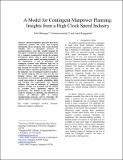A Model for Contingent Manpower Planning: Insights from a High Clock Speed Industry
Author(s)
Bhatnagar, Rohit; Venkataramanaiah, S.; Rajagopalan, Anand
DownloadIMST013.pdf (183.5Kb)
Metadata
Show full item recordAbstract
Intense competitive pressures have led to compressed product life cycles and frequent introduction of new products. This creates demand volatility and a consequent pressure on manufacturing to meet this variable demand. In this paper we model the manpower planning issues for a computer manufacturer during the product introduction phase when a quick ramp-up of production to meet rapidly increasing demand is a key requirement. A mix of permanent and contingent workers with different skill sets is considered. Some important issues addressed in this research are (a) how to assign workers with different skills to maximize production (b) what is the induction rate of contingent workers to achieve the desired ramp-up and (c) what are the key decision factors that impact manufacturing performance An LP model is proposed to minimize overall costs subject to complex scheduling, skills, and learning rate requirements. Our analysis indicates that cost of induction of contingent workers, overtime cost premium, and the amount of overtime have significant impact on performance. The findings of the study will be useful to managers in planning and allocation of workers of different skills to various manufacturing processes and to determine the optimal number of contingent workers to induct.
Date issued
2003-01Series/Report no.
Innovation in Manufacturing Systems and Technology (IMST);
Keywords
contingent workers, demand ramp-up, manpower planning